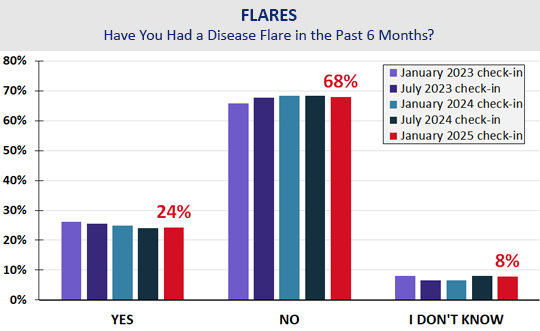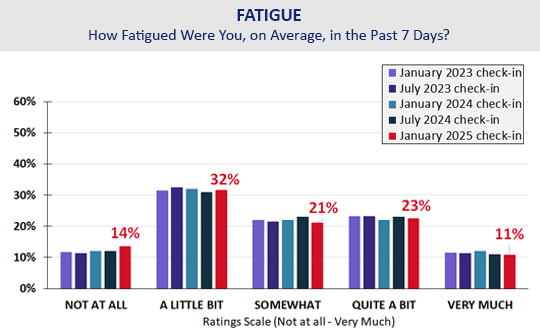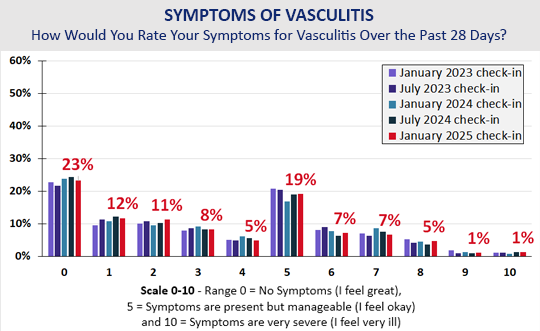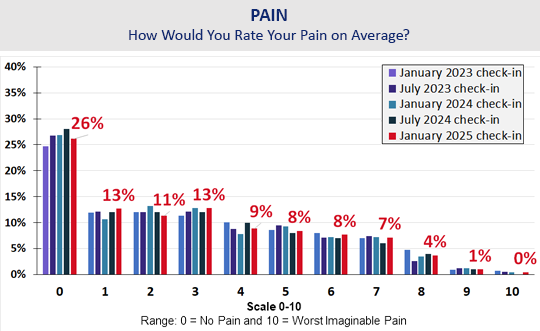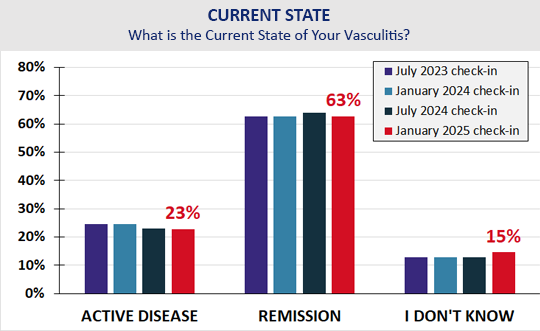VPPRN Patient-Powered Research

VPPRN Community Dashboard
6-MONTH CHECK-IN FORMS (Jan 2023-Jan 2025)
Every January and July, we ask our VPPRN community to check-in and share updates on their health.
Take a look below to see what we learned about flares, fatigue, pain, symptoms of vasculitis, and members’ current state of their vasculitis at the 2023, 2024, and January 2025 check-ins.
What did we learn about FLARES and VASCULITIS?
Overall, we see similar rates of reported flares at the check-ins in 2023, 2024, and January 2025.
- More than two-thirds of patients in the VPPRN community did NOT report a flare of their vasculitis in the past 6 months.
- Approximately 24% of patients did report a flare.
To better understand why some patients with vasculitis experience flares and some do not, we need the VPPRN community to continue to provide patient data to do the research needed to find answers. Patients power research in vasculitis! Please continue to share your health updates with the VPPRN and continue to stay engaged in research.
What did we learn about FATIGUE and VASCULITIS?
Overall, we see similar ratings of fatigue from our VPPRN community in 2023, 2024, and January 2025.
At the January 2025 check-in, we learned that:
- Most patients (approximately 87%) experience some fatigue related to their vasculitis. This is consistent with the Network scores from the 2023 and 2024 check-ins.
Fatigue is common among patients with vasculitis. Patients may have fatigue even if other vasculitis symptoms are under control. By completing the VPPRN check-in forms every 6 months, it will tell us more about fatigue and its impact on quality of life for people living with vasculitis. This research is vital and may lead us to identify ways to improve overall quality of life.
What did we learn about SYMPTOMS of VASCULITIS?
The scores for symptoms of vasculitis from the January 2025 check-in are comparable to the scores in the previous check-ins.
- Most patients reported as having no symptoms of vasculitis (23% with score = 0) over the past 28 days. This is similar to the scores in the previous check-ins.
- While the majority of the VPPRN community scored on the lower half of the scale (78% with scores 0-5), there were approximately 7% scored on the higher end, with scores ranging from 8-10. This is consistent with the ratings in 2023 and 2024.
Why the range of responses? We can’t say for sure. Right now, we don’t have all the answers – some people do better than others, and we’re still learning why. That’s why your check-ins with the VPPRN every 6 months are so important. Even if there’s nothing new to report or your vasculitis is quiet, your updates help us see the full picture over time. The more we learn from everyone’s experiences, the closer we get to answers that can help all of us.
What did we learn about PAIN and VASCULITIS?
We saw similar ratings for pain at the 2023, 2024, and January 2205 check-ins.
- Approximately 50% of patients experienced little to no pain on average, with scores ranging from 0-2 on a scale of 0-10.
- Alternatively, 28% of patients with vasculitis experienced moderate to severe pain with scores 5 and above in the 2023, 2024, and January 2025 check-ins.
Why do some people experience more pain than others? That’s a great question — and one we’re working hard to understand better. By collecting information through the VPPRN 6-month check-in forms, we can start to see patterns across the community. Every check-in helps us get one step closer to understanding why these differences happen and how to improve care for everyone living with vasculitis.
What did we learn about Members' CURRENT STATE of VASCULITIS?
Network members reported similar responses in 2023, 2024, and January 2025 regarding the current state of their vasculitis.
- About two-thirds of patients in the VPPRN community reported that they are currently in remission. This is encouraging to see.
- However, we saw 23% of patients who reported that their vasculitis is currently active. This is similar to the responses in 2023 and 2024.
To better understand why some patients with vasculitis are in remission and some are not, patient data is key. We need the VPPRN community to continue to provide their health updates to us. The data provided is mobilizing our team of doctors and researchers with the information they need to work towards improving the quality of life for all patients across all types of vasculitis and ages.
How Do You Compare to Others in the VPPRN Community?
Click below and see how patients with each type of vasculitis compare with the VPPRN community as a whole.
Compared to patients with other forms of vasculitis, patients with Behçet’s Disease (BD) reported more flares and higher scores for fatigue, symptoms of vasculitis, and pain at the January 2025 check-in. Additionally, a larger percentage of patients with BD reported their vasculitis as active.
At the January 2025 check-in, patients with central nervous system (CNS) vasculitis reported more flares and higher scores for fatigue, symptoms of vasculitis, and pain. Additionally, a higher percentage of patients with CNS vasculitis reported their vasculitis as active.
At the January 2025 check-in, patients with cryoglobulinemic vasculitis (cryoglobulinemia) reported, on average, higher levels of fatigue, vasculitis-related symptoms, and pain compared to patients with other types of vasculitis. A larger percentage of patients with cryoglobulinemic vasculitis also described their disease as currently active. However, the percentage of patients reporting flares was similar between those with cryoglobulinemic vasculitis and the broader VPPRN community.
Compared to patients with other forms of vasculitis, patients with eosinophilic granulomatosis with polyangiitis (EGPA) reported similar scores/ratings for fatigue, pain, and current state of vasculitis at the January 2025 check-in. Patients with EGPA, however, reported more flares and higher scores/ratings for their symptoms of vasculitis over the past 28 days.
Compared to patients with other forms of vasculitis, patients with giant cell (temporal) arteritis (GCA) reported similar scores/ratings for flares, fatigue, pain, and members’ current state of vasculitis at the January 2025 check-in. We do see a difference in scores for symptoms of vasculitis, with a higher percentage of patients with GCA reporting no symptoms at all.
At the January 2025 check-in, patients with granulomatosis with polyangiitis (GPA) reported similar levels of fatigue, vasculitis symptoms, and pain compared to other Network members. However, fewer patients with GPA reported experiencing flares, and a higher percentage indicated their vasculitis was in remission.
Compared to patients with other types of vasculitis, those with IgA vasculitis (Henoch-Schönlein) reported similar levels of fatigue, pain, and vasculitis symptoms. However, a greater percentage of patients with IgA vasculitis reported experiencing flares and active disease at the January 2025 check-in.
At the January 2025 check-in, patients with microscopic polyangiitis (MPA) reported similar levels of fatigue, pain, vasculitis symptoms, and flare rates compared to patients with other forms of vasculitis. However, a smaller percentage of patients with MPA reported having active disease.
At the January 2025 check-in, patients with polyarteritis nodosa (PAN) reported similar levels of flares, fatigue, vasculitis symptoms, pain, and active disease compared to patients with other types of vasculitis.
At the January 2025 check-in, patients with Takayasu’s arteritis (TAK) reported similar levels of pain compared to those with other types of vasculitis. However, they reported fewer flares, higher levels of fatigue and vasculitis symptoms, and a lower percentage indicated active disease.
At the January 2025 check-in, patients with urticarial vasculitis reported similar levels of fatigue and vasculitis symptoms compared to those with other forms of vasculitis. However, they reported more frequent flares, higher pain levels, and a greater percentage indicated active disease.
At the January 2025 check-in, patients with other/suspected vasculitis diagnosis reported similar levels of flares, fatigue, vasculitis symptoms, pain, and disease status compared to those with other forms of vasculitis. However, a smaller percentage of these patients reported their vasculitis as being in remission.
Thank You!
Thank you to the VPPRN community members who shared their health updates with us in 2023 and 2024!
We appreciate your enthusiasm and continued engagement with the VPPRN.

What’s Next? More Research!
There is still much to learn about vasculitis, and the VPPRN community can change that.
The VPPRN is a PATIENT-POWERED network which means that PATIENTS POWER VASCULITIS RESEARCH. The more patient data our VPPRN community provides, the more answers we can find.
- Why do some patients do better than others?
- How can we better understand why these differences exist?
The answer is RESEARCH. Please stay involved and engaged in the VPPRN, and please continue to share your health updates every January and July.
We are stronger together.
Together we make a difference.
Are you a member of the VPPRN?
Our vision is to improve the health of vasculitis patients by developing early-diagnosis methods, discovering more effective treatments, and finding cures. We invite patients with vasculitis, caregivers and parents/guardians of patients with vasculitis to come together to learn more about symptoms, share experiences, and to become a part of a research network to improve lives.
You can help us find answers for the questions most important to you and other patients living with vasculitis.
Questions?
The Vasculitis Patient-Powered Research Network (VPPRN) is here to make participation in the Network easy for you. The VPPRN Network Manager, Christine Yeung, is available if you have any questions or concerns.
- Email: christine.yeung@pennmedicine.upenn.edu
- Call/Text: (215) 200-6147

